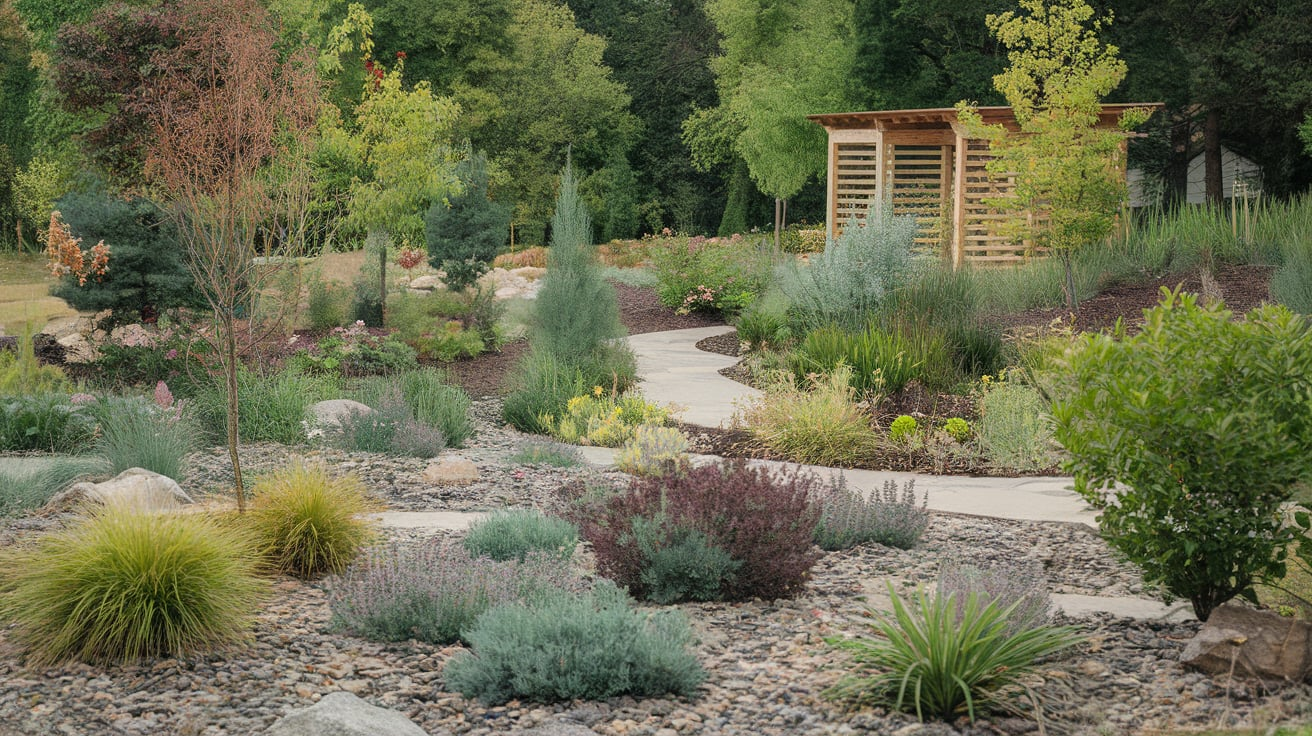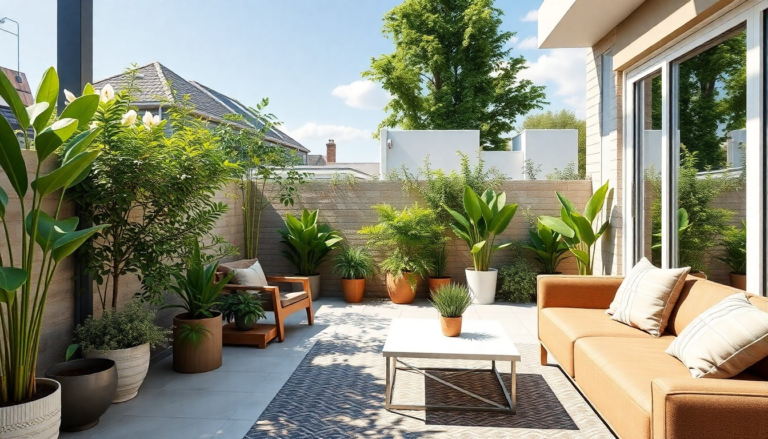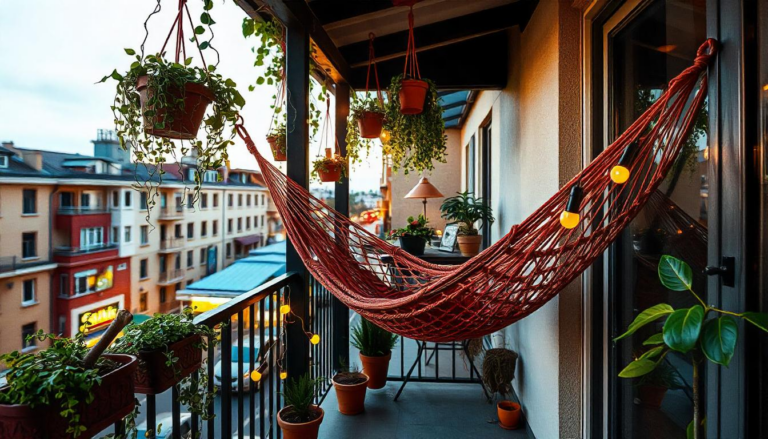26 Landscaping Ideas to Transform Your Outdoor Space

Landscaping doesn’t just boost curb appeal—it whispers to your guests, “Come on in, something special lives here.”
Whether you have a postage-stamp patio or a sprawling yard that feels like it could host a Renaissance fair, there’s a landscape idea here waiting to make your outdoor space sing.
And I won’t beat around the bush—pun very much intended—because you came for landscaping inspiration, not poetic filler.
Let’s dive into 26 landscaping ideas that blend charm, function, and down-to-earth creativity. Ready? Grab your garden gloves.
1. Native Plant Gardens
Native plants are like the hometown heroes of landscaping. They thrive without being needy—no special soil, no pampering.
Why’s this a game changer? Because native plants are built for your climate, meaning less watering, fewer pests, and lower maintenance.
They also support local pollinators, so you’re essentially building a five-star resort for bees and butterflies.
In my backyard, switching to native plants meant I stopped battling aphids and started sipping lemonade instead.
Look into local varieties like coneflowers, milkweed, or black-eyed Susans depending on your region.
2. Layered Garden Beds
Think of garden beds like lasagna—layering makes all the difference.
Tall grasses or shrubs in the back, medium plants in the middle, low growers or flowers up front.
This isn’t just eye candy. Layered beds maximize color, texture, and dimension, making small yards feel expansive and large yards feel intentional.
You don’t need to be a landscape architect—just follow the sunlight and trust your eye.
3. Curved Pathways
Straight paths are efficient, but curved paths are romantic.
They invite exploration and guide the eye like a gentle suggestion. Plus, they feel way less rigid.
Use materials like gravel, flagstone, or pavers to make the curve feel natural.
Frame it with low hedges or creeping thyme, and suddenly your yard has the kind of charm you’d expect from a Jane Austen novel.
4. Vertical Gardens
If you’re short on space, go up. Vertical gardens are ideal for balconies, fences, or narrow side yards. Think hanging planters, stacked pots, or living walls.
A friend of mine once turned an old wooden ladder into a vertical herb garden.
Not only did it save space, but it became the most Instagrammed part of their home.
Vertical landscaping is a fantastic way to grow herbs, succulents, or even strawberries without needing a full garden plot.
5. Outdoor Lighting
Landscaping doesn’t clock out at sunset. Outdoor lighting transforms your yard into a magical place where evening walks feel like strolls through a dream.
Use solar-powered lights along pathways, string lights on pergolas, or uplighting for trees.
According to the American Society of Landscape Architects, outdoor lighting is one of the top features that boosts property value.
It’s like jewelry for your yard—subtle, but striking.
6. Edible Landscaping
Why not snack while you weed? Edible landscaping blends beauty and practicality.
Replace hedges with blueberry bushes, or let kale, rainbow chard, and nasturtiums bring color to your borders.
There’s a certain joy in watching guests nibble on cherry tomatoes from your walkway like it’s no big deal.
Plus, you get fresh food without needing a separate vegetable garden.
7. Xeriscaping
Xeriscaping is landscaping’s answer to minimalism.
It’s all about reducing the need for water and maintenance—ideal for dry climates or those allergic to high water bills.
Swap thirsty lawns for gravel, mulch, succulents, and drought-tolerant plants. You’ll save water, time, and money—while still achieving a designer-level look.
According to the EPA, xeriscaping can reduce outdoor water use by 60% or more. That’s not just savings—that’s smart living.
8. Fire Pit Areas
There’s something primal about gathering around a fire.
Whether you go for a portable metal fire bowl or a custom-built stone pit, this is one of the best ways to bring people together.
Add gravel or flagstone underfoot, surround with Adirondack chairs, and you’ve got yourself a hangout zone.
Bonus points for roasting marshmallows under the stars.
9. Raised Garden Beds
Raised beds aren’t just for growing veggies—they’re architectural elements that organize your space, prevent soil compaction, and add visual appeal.
Use materials like wood, corrugated metal, or stone. They’re easier on the back, protect against weeds, and can turn even poor soil into a productive garden.
And let me tell you—watching lettuce sprout from a raised bed you built yourself feels like winning at adulting.
10. Rock Gardens
Rock gardens add visual weight and serenity. They require little maintenance and work especially well in dry or shady spots where other plants struggle.
Mix boulders, river stones, gravel, and alpine plants. It’s like creating a miniature mountain scene in your yard. Bonus: rocks don’t need pruning.
11. Butterfly Gardens
Invite nature’s most elegant visitors by planting a butterfly garden. Use milkweed, zinnias, bee balm, and lavender—all crowd-pleasers for pollinators.
Not only will you add motion and life to your space, but you’ll also be contributing to pollinator conservation.
Your garden becomes an ecological love letter.
12. Water Features
A small fountain or pond adds that soothing, spa-like quality. Even a tabletop water bowl with a tiny pump can offer that calming trickle.
You don’t need a koi pond and a waterfall—though I’m not stopping you.
Just know that the sound of water reduces stress, attracts birds, and masks traffic noise.
13. Natural Privacy Screens
Forget ugly fences. Use plants as privacy screens. Bamboo, arborvitae, or tall ornamental grasses can block out nosy neighbors while still looking lush.
Add a row of fast-growing Leyland cypress, and you’ve got a green wall that doesn’t need painting or repairs. Win-win.
14. Mulch Magic
Mulch is the unsung hero of landscaping. It retains moisture, smothers weeds, and keeps plant roots cool.
Use shredded bark, straw, or gravel, depending on your look.
Mulch also instantly polishes up a bed. I once mulched the front yard right before an open house, and the place looked 10x more expensive overnight.
15. Pergolas and Arbors
Pergolas and arbors add structure and drama. They define outdoor spaces, create shade, and support vining plants like wisteria, clematis, or grapes.
Paint it white for cottage charm or stain it dark for a modern look. Either way, you’ve created a destination—not just a yard.
16. Lawn Alternatives
Let’s talk about grass. It’s beautiful… and needy.
Lawn alternatives like clover, moss, creeping thyme, or groundcovers are lower maintenance, eco-friendly, and often more interesting.
According to the National Wildlife Federation, traditional turf grass accounts for over 50% of urban water use.
Swapping it out saves time, money, and the planet.
17. Container Clusters
Group containers in clusters of odd numbers—three, five, or seven—for a layered, designer feel. Use varying heights and materials for contrast.
This is perfect for renters or seasonal decorators. I’ve changed my container garden’s vibe three times this year already. No regrets.
18. Artistic Touches
Add unexpected art to your yard. Think sculptures, mirrors, mosaic stepping stones, or wind chimes. It personalizes your space and tells your story.
I once tucked a vintage birdcage in a shady corner, filled it with fairy lights, and suddenly—enchanted forest vibes.
19. Wildflower Lawns
Why mow when you can bloom? Wildflower lawns are gaining popularity for good reason.
They’re pollinator-friendly, low-maintenance, and straight-up beautiful.
Seed a portion of your yard with a wildflower mix suited to your zone. Just give it sun, patience, and admiration.
20. Sensory Gardens
Appeal to all five senses. Use lavender or mint for scent, grasses for sound, succulents for touch, and maybe a few edibles for taste.
Create paths that invite barefoot walks. Add wind sculptures. Landscaping doesn’t have to be visual—it can be a full-body experience.
21. Mixed Border Planting
Skip the single-species monotony. Mix perennials, grasses, bulbs, and shrubs in your borders for four-season interest.
It’s like creating a buffet of textures and colors. Plus, if one plant flops, the others keep the show going.
22. Gravel Patios
Gravel patios are cheaper and easier than concrete, and they bring a rustic-chic vibe. Add a few café chairs, a fire bowl, and you’re in Tuscany without the airfare.
They drain well, need little maintenance, and feel grounding underfoot. Add stepping stones if you want to fancy it up.
23. Rain Gardens
Capture rainwater in style. Rain gardens are slightly sunken areas filled with moisture-loving plants that absorb runoff from roofs and driveways.
They reduce flooding, filter pollutants, and add visual interest. Cities across the U.S. are even offering rebates for rain gardens.
24. Outdoor Rooms
Divide your yard like your home—create rooms. A dining area, a reading nook, a hammock zone. Use hedges, pergolas, or planters to create separation.
It turns your backyard into a livable extension of your house. Think of it like open-concept living, only alfresco.
25. Retaining Walls with Style
If you’re on a slope, don’t fight it—celebrate it. Retaining walls can be both functional and fabulous. Use natural stone, timber, or concrete.
Add built-in seating, lighting, or even garden beds within the walls. You’re solving erosion and designing beauty.
26. Wildlife Habitats
Design with nature in mind. Add bird baths, bee houses, logs for frogs, and native plants for cover and food.
The National Wildlife Federation offers certification for Certified Wildlife Habitats, and yes, you can absolutely brag about it to your guests.
Final Thought: Landscaping isn’t about perfection—it’s about connection.
To your home, to the seasons, to the creatures that visit, and to your own slice of peace under the sky.
If you try even three of these ideas, your outdoor space will thank you—quietly, with rustling leaves, bird songs, and blooms where there used to be blank space.
Want help planning one of these ideas for your yard? Just say the word.






